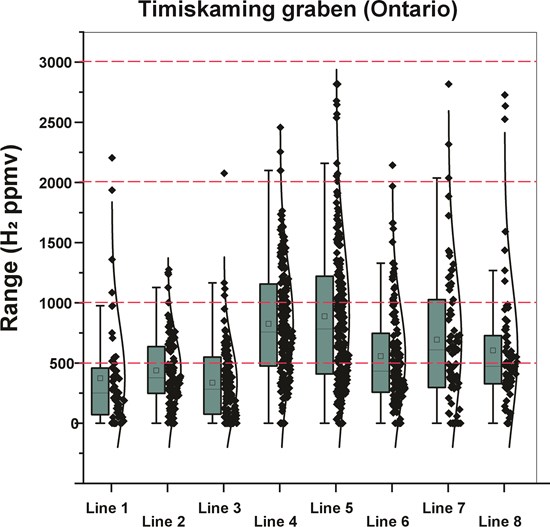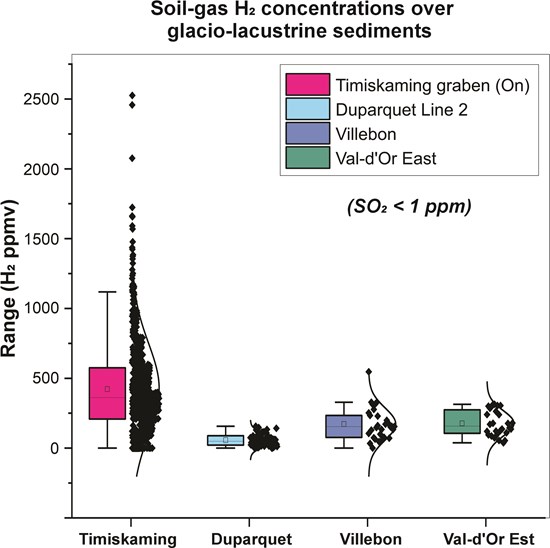DiagnaMed and QIMC Confirm Major Expansion of Hydrogen Zone by Over 11 Kilometers in Ontario's Temiscamingue Graben
Rhea-AI Summary
DiagnaMed (OTCQB: DGNMF) and QIMC reported new soil-gas results confirming a >11 km northward extension of the natural hydrogen system in Ontario's Témiscamingue Graben.
Across 454 samples on Lines 5–8 (45.3 km, 454 stations) the survey found 251 samples >500 ppm H2, 116 >1,000 ppm, 19 >2,000 ppm, and a peak of 2,817 ppm. The study area spans ~11.3 km N–S and 23 km E–W (~260 km²). Median H2 in the graben is 375 ppm versus 50–125 ppm in Abitibi sites; methane was detected in <3% of samples and average CO2 was 0.6%.
Positive
- Extension confirmed of hydrogen system by >11.3 km north-south
- 454 soil-gas samples collected across Lines 5–8 (45.3 km)
- 251 samples exceeded 500 ppm H2
- 116 samples exceeded 1,000 ppm H2
- Peak hydrogen concentration of 2,817 ppm
- Median H2 375 ppm vs 50–125 ppm in Abitibi comparisons
Negative
- None.
News Market Reaction 1 Alert
On the day this news was published, DGNMF gained 1.72%, reflecting a mild positive market reaction.
Data tracked by StockTitan Argus on the day of publication.
454 Samples Analyzed -
Toronto, Ontario--(Newsfile Corp. - October 27, 2025) - DiagnaMed Holdings Corp. (CSE: DMED) (OTCQB: DGNMF) ("DiagnaMed" or "DMED" or the "Company"), in partnership with Québec Innovative Materials Corp. (CSE: QIMC) (OTCQB: QIMCF) (FSE: 7FJ), is pleased to announce that new soil-gas survey results from the Ontario section of the Témiscamingue Graben have confirmed a major northward extension of the natural hydrogen system by more than 11 kilometers.
A total of 454 soil-gas samples were collected and analyzed across lines 5-8. Results show 251 samples exceeding 500 ppm hydrogen (H₂), including 116 above 1,000 ppm, 19 above 2,000 ppm, and a peak concentration of 2,817 ppm. The data clearly demonstrate that hydrogen concentrations intensify toward the north, confirming a vast, structurally controlled degassing system within the Ontario portion of the Témiscamingue Graben.
"These new results mark a significant milestone for DiagnaMed as we continue to advance the Ontario-Quebec Hydrogen Corridor with QIMC," said John Karagiannidis, President & CEO of DiagnaMed. "Our work together demonstrates not only the scale of the hydrogen system extending over 11 kilometers but also its potential as a foundation for clean, off-grid energy to power AI and digital infrastructure. This data strengthens our vision of merging clean-tech with next-generation computing solutions."
The survey, conducted in collaboration with the Institut National de la Recherche Scientifique (INRS) under the supervision of Prof. Marc Richer-Laflèche, continues to expand the scale and continuity of this fault-controlled hydrogen corridor.
"As part of our commitment to sustainable regional development, DiagnaMed is advancing discussions with the Témiscamingue First Nation on establishing an AI data infrastructure project powered by off-grid natural hydrogen," added Karagiannidis. "This initiative aims to position the Ontario-Quebec Hydrogen Corridor as both a clean energy hub and a next-generation data resource center-enabling Indigenous and local communities to participate directly in Canada's emerging digital and energy economies."
Geological and Scientific Results
In the second phase of fieldwork conducted across the municipalities of Couttsville, Thwaites, and Belle-Vallée (Ontario), the INRS-QIMC team completed four new Soil-Gas survey lines totaling 45.3 km and 454 stations. These additional surveys, located north of Lines 1 to 4, were designed to confirm the high hydrogen concentrations observed to the south, particularly along Line 4.
The statistical distribution of the data measured along Lines 5 to 8 was compared with that of Lines 1 to 4 (Fig. 1). The presence of strong hydrogen concentrations was confirmed on Line 5. Overall, hydrogen (H₂) concentrations are generally higher along Lines 6 to 8 than in the southern portion of the survey area (Lines 1 and 2). This demonstrates a clear north-south variability in the natural hydrogen potential within the Ontario segment of the Témiscamingue Graben system. The distance separating Lines 4 and 5 is 1.6 km, and the survey area covering Lines 1 to 8 extends over 11.3 km along the north-south axis and 23 km east-west-representing an area of approximately 260 km².
Figure 1. Statistical compilation of Soil-Gas hydrogen data measured along Lines 1 to 8 within the geochemical survey area of July 2025 (Témiscamingue Graben, Ontario).
To view an enhanced version of this graphic, please visit:
https://images.newsfilecorp.com/files/11470/272001_9645a60aa46df897_001full.jpg
"The distribution of data, with a large number (47) hydrogen concentrations exceeding 1,500 ppm, is a clear indication of the hydrogen-rich nature of the soils in the Témiscamingue valley. These new results confirm what had already been demonstrated in 2024 for the Quebec section of the graben, particularly around St-Bruno-de-Guigues (QIMC)," notes Professor Marc Richer-Laflèche.
"To date, scientific literature does not report any comparable geological context showing both such high hydrogen concentrations and such a large areal distribution," observes Professor Richer-Laflèche. For the Témiscamingue Graben valley, this suggests a geological environment combining several essential elements for natural hydrogen generation:
- Iron-rich sources (iron formations, peridotites, basalts, Nippissing dykes);
- Optimal water supply (Ottawa River watershed); and
- Proterozoic tectonic structures reactivated during the Paleozoic and Cenozoic eras, allowing water to descend at depth and hydrogen to migrate upward into reservoirs (limestone and dolomitic rocks) or surface-reaching fractures.
It is important to emphasize that the Quaternary geological setting of the Témiscamingue valley, in both Ontario and Quebec, is dominated by a thick layer of fine-grained glaciolacustrine sediments. This layer may explain some of the hydrogen distribution characteristics observed in the valley, particularly the lateral spread of high hydrogen concentrations across broad areas.
Conceptually, the presence of groundwater and fine-grained Quaternary silty-clay sediments could favor the horizontal dispersion of hydrogen; however, the elevated concentrations suggest the substrate itself may be a hydrogen source. To verify this, new Soil-Gas data were compiled from three Abitibi regions (Duparquet, East Val-d'Or - airport sector, and Lake Villebon east of Val-d'Or) where volcanic and sedimentary rocks are also overlain by thick fine-grained glaciolacustrine sediments.
The comparison (Fig. 2) highlights the difference between hydrogen concentrations in the Témiscamingue Graben valley and those in the Abitibi sectors. The Abitibi sites show median hydrogen values of 50 to 125 ppm, whereas the Témiscamingue valley shows a median of 375 ppm, with numerous anomalous values above 1,000 ppm-levels not observed in Abitibi soils.
Consequently, the data available to date suggest that glaciolacustrine sediments are not the cause of the hydrogen enrichment observed in the Témiscamingue Graben valley. This conclusion is further supported by the near absence of measurable methane (CH₄ detected in fewer than
Figure 2. Statistical compilation of Soil-Gas hydrogen data measured in the Ontario section of the Témiscamingue Graben and along profiles conducted in the Duparquet, Villebon, and East Val-d'Or regions. The data shown in this diagram are filtered to include only samples containing less than 1 ppm of SO₂.
To view an enhanced version of this graphic, please visit:
https://images.newsfilecorp.com/files/11470/272001_9645a60aa46df897_002full.jpg
The data presented in Figure 2 originate from an INRS research project funded by FRQNT and part of the PhD thesis work of Antoine Cuckovic (INRS).
About DiagnaMed Holdings Corp. (DMED)
DiagnaMed Holdings Corp. (CSE: DMED) (OTCQB: DGNMF) is a Canadian technology company that delivers innovative solutions across clean-tech, data infrastructure, and life sciences. By integrating artificial intelligence, advanced analytics, and sustainable energy systems, DiagnaMed aims to enable the next generation of autonomous, off-grid data operations powered by clean natural hydrogen. Visit www.DiagnaMed.com.
About Québec Innovative Materials Corp. (QIMC)
Québec Innovative Materials Corp. (CSE: QIMC) (OTCQB: QIMCF) (FSE: 7FJ) is a mineral exploration and development company dedicated to exploring and harnessing the potential of North America's abundant resources, specializing in natural (white) hydrogen and high-grade silica deposits.
For more information, please contact:
DIAGNAMED HOLDINGS CORP.
John Karagiannidis
President & CEO
Email: info@diagnamed.com
Tel: +1 514-726-7058
Neither the Canadian Securities Exchange nor its Regulation Services Provider have reviewed or accept responsibility for the adequacy or accuracy of this release.
Cautionary Statement
Certain statements in this news release are forward-looking statements, including with respect to future plans, and other matters. Forward-looking statements consist of statements that are not purely historical, including any statements regarding beliefs, plans, expectations or intentions regarding the future. Such information can generally be identified by the use of forwarding-looking wording such as "will", "may", "expect", "could", "can", "estimate", "anticipate", "intend", "believe", "projected", "aims", and "continue" or the negative thereof or similar variations. The reader is cautioned that assumptions used in the preparation of any forward-looking information may prove to be incorrect. Events or circumstances may cause actual results to differ materially from those predicted, as a result of numerous known and unknown risks, uncertainties, and other factors, many of which are beyond the control of the Company, including but not limited to, business, economic and capital market conditions, the ability to manage operating expenses, and dependence on key personnel. Such statements and information are based on numerous assumptions regarding present and future business strategies and the environment in which the Company will operate in the future, anticipated costs, and the ability to achieve goals. Factors that could cause the actual results to differ materially from those in forward-looking statements include, the continued availability of capital and financing, litigation, failure of counterparties to perform their contractual obligations, loss of key employees and consultants, and general economic, market or business conditions. Factors that could cause actual results to differ materially from those anticipated in these forward-looking statements are described under the caption "Risk Factors" in Company's management's discussion and analysis for the Three and Six Months Ended March 31, 2025 ("MD&A"), dated May 28, 2025, which is available on the Company's profile at www.sedarplus.ca. Forward-looking statements contained in this news release are expressly qualified by this cautionary statement. The reader is cautioned not to place undue reliance on any forward-looking information. The forward-looking statements contained in this news release are made as of the date of this news release. Except as required by law, the Company disclaims any intention and assumes no obligation to update or revise any forward-looking statements, whether as a result of new information, future events or otherwise.
This news release does not constitute an offer to sell or a solicitation of an offer to buy nor shall there be any sale of any of the securities in any jurisdiction in which such offer, solicitation or sale would be unlawful, including any of the securities in the United States of America. The securities have not been and will not be registered under the United States Securities Act of 1933, as amended (the "1933 Act") or any state securities laws and may not be offered or sold within the United States or to, or for account or benefit of, U.S. Persons (as defined in Regulation S under the 1933 Act) unless registered under the 1933 Act and applicable state securities laws, or an exemption from such registration requirements is available.

To view the source version of this press release, please visit https://www.newsfilecorp.com/release/272001









